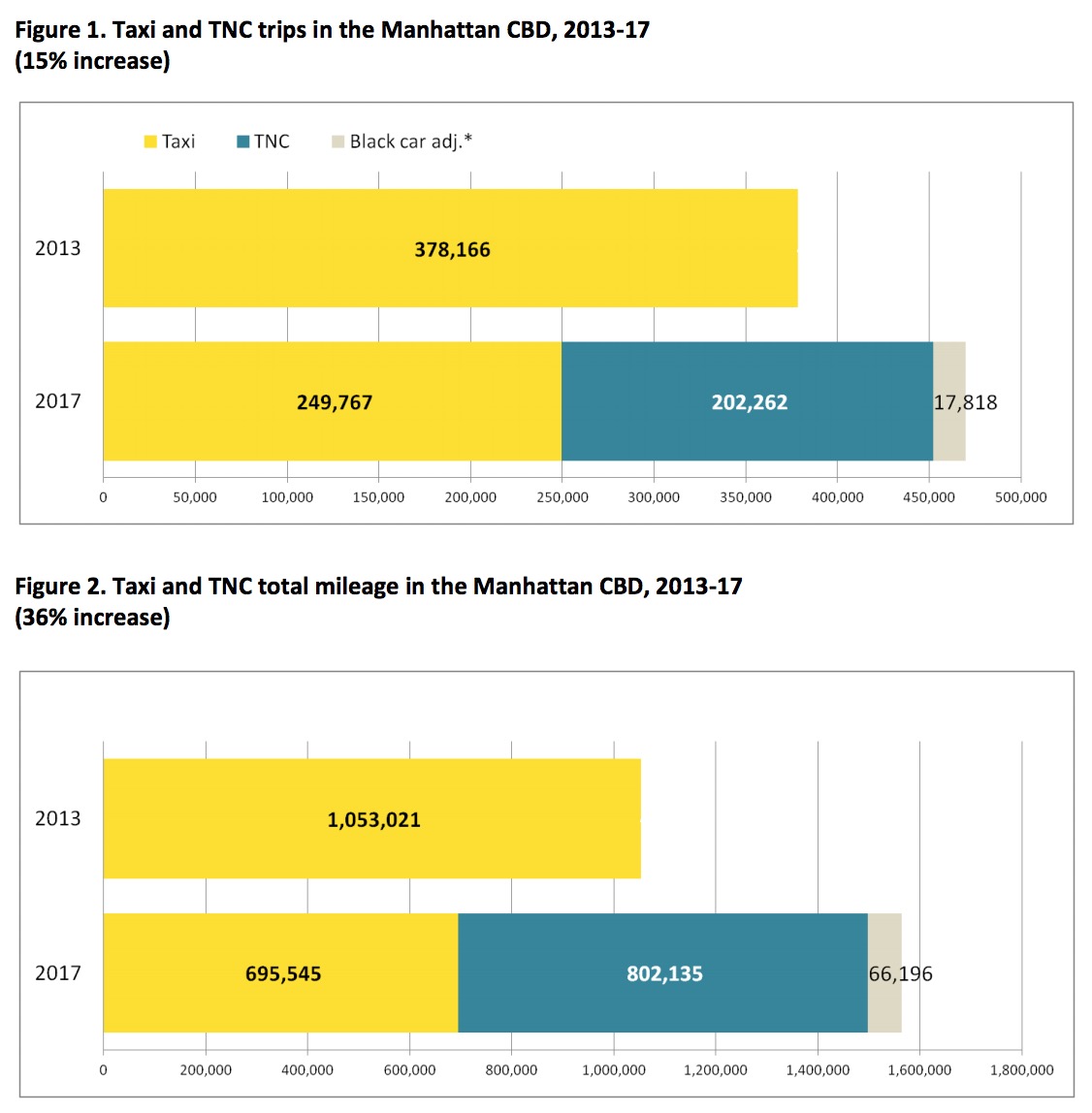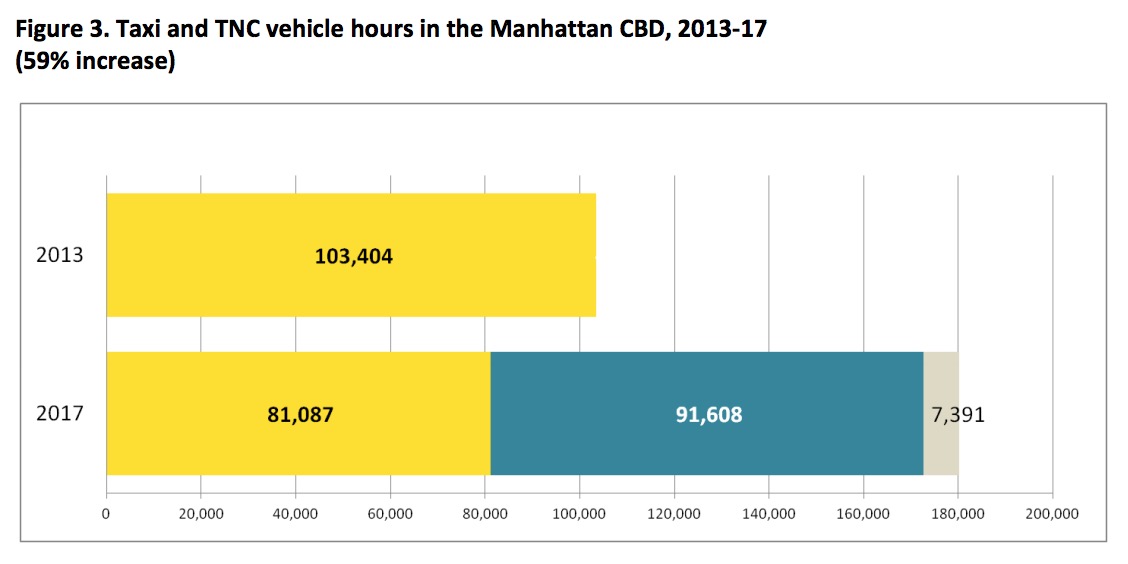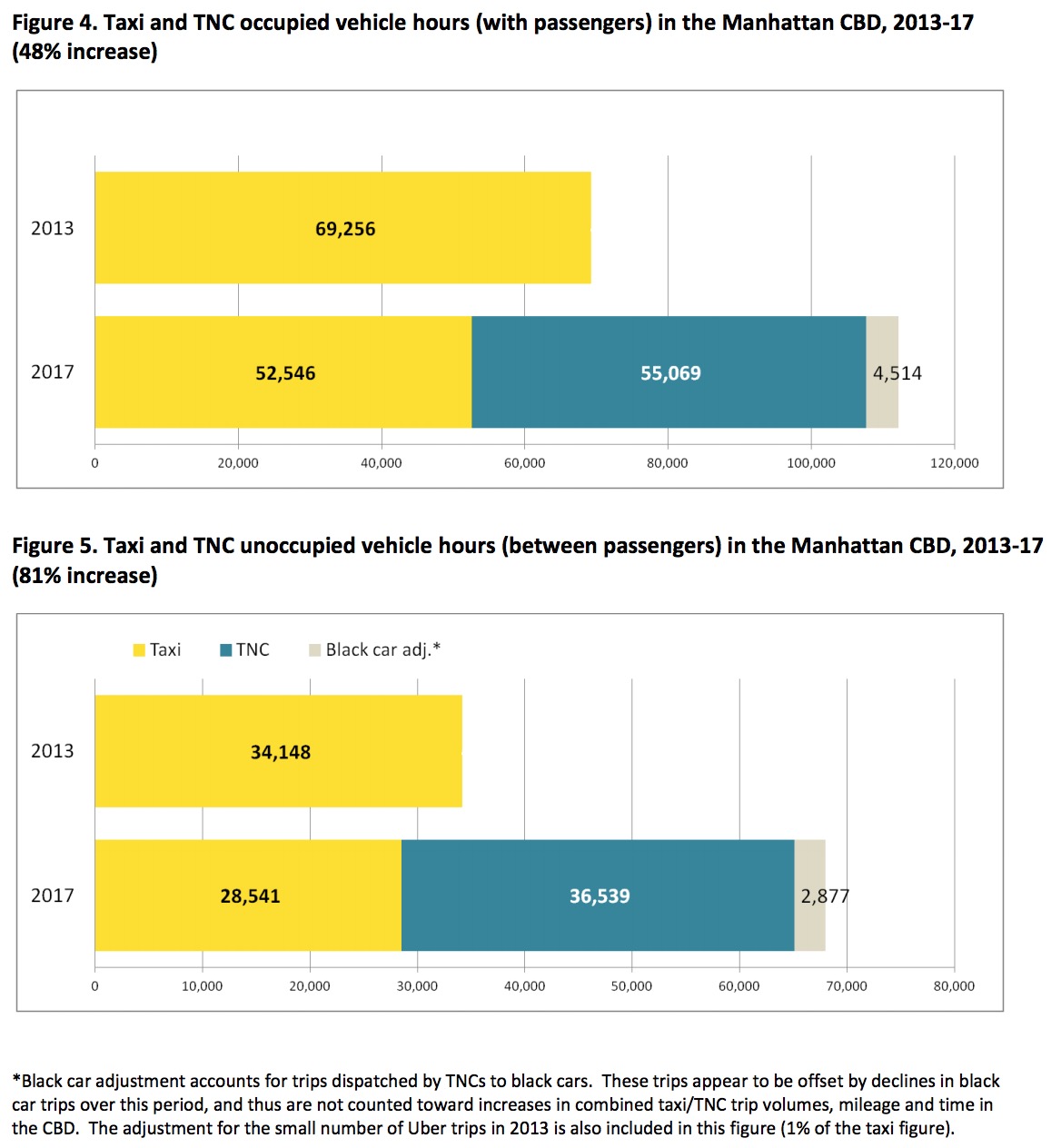SCHALLER CONSULTING
Summary
The rapid growth of app-based ride services such as Uber and Lyft has raised concerns in large U.S. cities such as New York. San Francisco, Chicago and Seattle about their impacts on traffic congestion and public transportation ridership. In New York City, the growth of app-based ride services (often called “Transportation Network Companies,” or TNCs) has raised questions about how anti-congestion plans being developed by Governor Andrew Cuomo and Mayor Bill de Blasio should address TNCs’ contributions to traffic congestion.
This report examines the impact of TNC growth on traffic conditions in the Manhattan Central Business District (CBD), defined as 60 Street to the Battery, river to river. Using newly available data on TNC trips, the report presents a more detailed analysis of CBD traffic conditions than has been possible previously, isolating the impact of TNC growth in the Manhattan CBD during the most congested part of the day — weekdays between 8 a.m. and 7 p.m.
- The analysis takes account both the rapid growth of TNCs and declines in yellow cab activity, thus focusing on net growth of the combined taxi/TNC sector. Key findings are:
- Taxi/TNC trips increased by 15 percent on the average weekday in June 2017 compared with June 2013.
- Total taxi/TNC weekday mileage in the CBD increased by 36 percent from 2013 to 2017. Mileage increased more rapidly than trips due to a trend toward longer trips and lower utilization rates (percentage of mileage with passengers).
- The number of taxi/TNC vehicles in the CBD increased by 59 percent. Vehicles increased more rapidly than mileage due to slower traffic speeds.
- Total hours spent transporting passengers increased by 48 percent over the last four years, slightly less than the overall growth of vehicles in the CBD because utilization rates declined.
- The number of unoccupied taxi/TNC vehicles increased by 81 percent, more rapidly than overall vehicle hours due to declining utilization rates.
- Increases in trips, mileage and the number of vehicles in the CBD vary considerably during the day. The largest increases were from 4 p.m. to 6 p.m.., with the number of taxi/TNC vehicles more than doubling during this time period.
Large increases in the number of taxi/TNC vehicles in the CBD are an important source of slow traffic conditions in the Manhattan CBD. The very rapid growth in unoccupied vehicles in the CBD is of particular note since the increased time and mileage that drivers spend between trips exacerbates congestion but does not contribute to the mobility needs of New Yorkers. Reducing unoccupied time thus presents an opportunity to reduce Manhattan traffic congestion and improve both mobility (through less congested traffic) as well as driver incomes (through less time waiting for the next trip).
This report focuses on ways to reduce unoccupied time in the CBD by taxis and TNCs. The most promising option is for the City or State to mandate that Uber, Lyft and other TNCs limit the time that their drivers spend waiting for their next trip request, which now averages 11 minutes between trips. TNCs already utilize dispatch methods at airports across the country that could dramatically shorten unoccupied time between trips if utilized for dispatching CBD trips.
Yellow cabs could also be mandated to reduce their unoccupied time between trips. Since they predominantly respond to street hail rather than dispatch, however, the mechanism to achieve reductions in unoccupied time would be different for taxis than TNCs. The report discusses an approach of allocating yellow cabs a set amount of time that they can operate in the CBD during the business day.
A policy to reduce unoccupied time between trips would need to balance the benefits of reducing the number of vacant vehicles in congested traffic with the goal of maintaining good availability of TNC and taxi service when customers want a ride. Both unoccupied time of vehicles and waiting times for customers should be monitored during implementation and adjustments made as appropriate.
Reducing unoccupied time between trips for taxis and TNCs can substantially reduce overall vehicle mileage in the CBD and thus overall congestion levels. The report estimates that overall vehicle mileage could be reduced by 7 percent to 11 percent from eliminating unnecessary unoccupied time between trips.
These reductions, if combined with congestion pricing and a per-trip fee on taxi/TNC trips beginning in Manhattan (now being discussed as part of a comprehensive program to reduce congestion and raise money for public transit), would reverse most of the drop in CBD speeds since 2010. A program with these elements would reduce the number of vehicles in the CBD by 20 percent or more, offsetting most if not all of the 23 percent drop in traffic speeds since 2010.
Finally, the report discusses implications of this research for other cities, and for the anticipated arrival of autonomous vehicles in the near future. Although New York City presents unique circumstances compared with other large U.S. cities, there are clear lessons to be gained from the New York experience. Chief among these is the importance of the driver-driven nature of the supply of TNC service in which overall service hours are a product of decisions made by individual TNC driver about where and when to work and how many hours to drive. The dynamics underlying a driver-driven supply of service is likely to lead to excessive time spent between trips in cities across the country.
These findings also have significant implications for how fleets of shared autonomous vehicles are likely to affect traffic conditions in major cities as they are introduced in coming years. It is anticipated that for many years to come, Uber, Lyft and other ride service companies will have mixed fleets composed of both autonomous vehicles and human-driven vehicles. In the absence of policy intervention, expanding mixed fleets will further balloon the number of vacant vehicles occupied only by drivers waiting for their next trip request. The results in this report thus heighten concerns about traffic impacts from the arrival of autonomous vehicles. The results also underscore the need for public policy to address traffic impacts of both today’s TNCs and tomorrow’s fleets of mixed human driven and autonomously driven ride services.
Introduction
Manhattan traffic congestion is back in the news. In an interview this August, Governor Andrew Cuomo said the “time has come” to institute congestion pricing in the busiest and most congested parts of Manhattan. In October, Cuomo formed a 16-person panel to recommend steps to reduce congestion in New York City and produce a dedicated funding stream for the city’s subway and bus system. Also this fall, Mayor Bill de Blasio announced a series of steps to combat a 23 percent decline in Midtown traffic speeds since 2010, including banning deliveries on certain cross-streets and stepping up enforcement of parking and traffic rules.
Manhattan’s traffic problem imposes significant costs on both motorists and on people who never get into a motor vehicle. Most directly, congestion impedes the city’s buses, contributing to rapid declines in bus ridership over the last four years, as well as other motor vehicles. Congestion also increases the cost of freight movement, goods delivery and provision of on-site services ranging from construction of new commercial buildings to home repairs. These costs are passed on to consumers whether or not they personally have an automobile.
The drop in CBD speeds since 2010 is attributable to a variety of factors. These include rapid employment and population growth, increasing tourism and construction activity, and the rise of on-line shopping and growth in package deliveries, to name a few. Growth in all of these areas generates increased pressures on the unchanging amount of Manhattan street space.
Another important factor is the rapid expansion of Uber, Lyft and other “Transportation Network Companies” (TNCs) in New York City. There are now over 68,000 licensed TNC vehicles in the five boroughs. A previous Schaller Consulting study found that from 2013 to 2016, TNC growth added 600 million miles of travel to city streets. The study estimated that over half of citywide growth in mileage occurred in Manhattan and western Brooklyn and Queens.
This report builds on the previous study with a more fine-grained analysis that focuses on daytime traffic impacts in the Manhattan CBD — where congestion is most acute. The analysis utilizes newly available data on TNC trips that show where passengers were dropped off as well as where trips began. Inclusion of trip destination makes possible a far more detailed analysis of traffic conditions in the Manhattan CBD than has been possible previously. The analysis isolates the impact of TNC growth in the Manhattan CBD focusing on weekdays during the business day and in particular the afternoon peak, the most congested parts of the day.
Results show the net effects of several distinct trends. These include a continuing decline in yellow cab ridership and rapid growth in TNC ridership, the net result being increased overall trip-making by TNCs and taxis. This growth, combined with a trend toward longer trips (measured by mileage) and lower vehicle utilization, has led to rapid growth in vehicle miles of travel in the Manhattan CBD by the taxi/TNC sector. Compounded by slower traffic speeds, the number of taxi and TNC vehicles operating on CBD streets has increased even more rapidly than trips or mileage.
As trips and mileage have increased, the taxi/TNC sector has contributed to the worsening of congestion in the Manhattan CBD. It is difficult to quantify how much of the problem is attributable to these vehicles, however, due to lack of data on mileage by other types of vehicles (e.g., commercial vehicles, personal autos, etc.).
In addition to documenting growth in trips, vehicle mileage and vehicle hours of taxi and TNC drivers, the analysis also points to ways that these vehicles could help fix the congestion problem. The most promising avenue is to reduce the unoccupied time and mileage of taxis and TNCs. Over one thirds of drivers’ time in the CBD is spent unoccupied between passenger trips. The report discusses methods of reducing this unoccupied time and estimates the potential benefit to traffic speeds.
There are also implications for the anticipated arrival of shared autonomous vehicles, particularly in the long transition period during which TNC fleets have a mix of autonomous operations and human drivers. These implications are also discussed in the report.
Download full version (PDF): Fixing Manhattan’s Traffic Problem
About Schaller Consulting
www.schallerconsult.com
Schaller Consulting offers expertise in urban transportation policy toward the goals of enhancing urban mobility, environmental sustainability and road safety. Established in 1998, Schaller Consulting specializes in taxi and vehicle-for-hire regulatory policy; strategies to develop and enhance sustainable, multi-modal urban transportation networks; application of road and parking pricing; use of performance metrics in program planning and evaluation; and integration of public engagement and market research with program and project planning.
Tags: CBD, Central Business District, New York City, NY, NYC, TNCs, Transportation Network Companies









 RSS Feed
RSS Feed